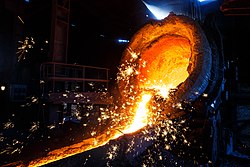
Back فولاذ البوتقة Arabic Gussstahl German Krisolŝtalo Esperanto Acero de crisol Spanish فولاد بوته Persian Upokasteräs Finnish Acier au creuset French मूषा इस्पात Hindi Čelični lijev Croatian Tégelyacélgyártás Hungarian
| Steels |
|---|
 |
| Phases |
| Microstructures |
| Classes |
| Other iron-based materials |

Crucible steel is steel made by melting pig iron (cast iron), iron, and sometimes steel, often along with sand, glass, ashes, and other fluxes, in a crucible. In ancient times steel and iron were impossible to melt using charcoal or coal fires, which could not produce temperatures high enough. However, pig iron, having a higher carbon content and thus a lower melting point, could be melted, and by soaking wrought iron or steel in the liquid pig-iron for a long time, the carbon content of the pig iron could be reduced as it slowly diffused into the iron, turning both into steel. Crucible steel of this type was produced in South and Central Asia during the medieval era. This generally produced a very hard steel, but also a composite steel that was inhomogeneous, consisting of a very high-carbon steel (formerly the pig-iron) and a lower-carbon steel (formerly the wrought iron). This often resulted in an intricate pattern when the steel was forged, filed or polished, with possibly the most well-known examples coming from the wootz steel used in Damascus swords. The steel was often much higher in carbon content (typically ranging in the area of 1.5 to 2.0%) and in quality (lacking impurities) in comparison with other methods of steel production of the time because of the use of fluxes. The steel was usually worked very little and at relatively low temperatures to avoid any decarburization, hot short crumbling, or excess diffusion of carbon; just enough hammering to form the shape of a sword. With a carbon content close to that of cast iron, it usually required no heat treatment after shaping other than air cooling to achieve the correct hardness, relying on composition alone. The higher-carbon steel provided a very hard edge, but the lower-carbon steel helped to increase the toughness, helping to decrease the chance of chipping, cracking, or breaking.[1]
In Europe, crucible steel was developed by Benjamin Huntsman in England in the 18th century. Huntsman used coke rather than coal or charcoal, achieving temperatures high enough to melt steel and dissolve iron. Huntsman's process differed from some of the wootz processes in that it used a longer time to melt the steel and to cool it down and thus allowed more time for the diffusion of carbon.[2] Huntsman's process used iron and steel as raw materials, in the form of blister steel, rather than direct conversion from cast iron as in puddling or the later Bessemer process. The ability to fully melt the steel removed any inhomogeneities in the steel, allowing the carbon to dissolve evenly into the liquid steel and negating the prior need for extensive blacksmithing in an attempt to achieve the same result. Similarly, it allowed steel to be cast by pouring into molds. The use of fluxes allowed nearly complete extraction of impurities from the liquid, which could then simply float to the top for removal. This produced the first steel of modern quality, providing a means of efficiently changing excess wrought iron into useful steel. Huntsman's process greatly increased the European output of quality steel suitable for use in items like knives, tools, and machinery, helping to pave the way for the Industrial Revolution.
- ^ A History of Metallography by Cyril Stanley Smith. MIT Press 1960. pp. 16–24 [ISBN missing]
- ^ Tylecote, R. F. (1992). A History of Metallurgy, Second Edition. London: Maney Publishing, for the Institute of Materials. p. 146. ISBN 978-0901462886.
© MMXXIII Rich X Search. We shall prevail. All rights reserved. Rich X Search